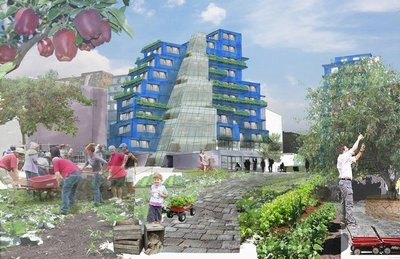April 8, 2010
100 plans for 100 gardens is goal of ‘urban food’ conference
You need some tomatoes? Grow ’em in the alley.
Some fresh beans? Grow ’em up the side of a building.
As more people gravitate to cities, urban design professionals are exploring best ways to use land and feed the people who inhabit it.
Next Thursday and Friday, April 16 and 17, at the College of Built Environments, urban design professionals and students will explore the urban food movement. They also aim to create 100 plans for 100 urban gardens that they hope will be launched by Seattle folks on May 8.
“Exploring the Role of Design in the Urban Food Movement” will begin at 6 p.m. on Thursday with a panel discussion in Gould Hall. The conversation continues Friday with an all-day charrette — basically a brainstorming session — for Spring into Bed, the city-sponsored effort to plant fruit and vegetable gardens that second Saturday in May.
The two-day meeting parallels a Built Environment Lab course, an interdisciplinary design studio on vertical farming and sustainable site design that began winter quarter and continues in a related version this spring. The studio is led by Branden Born, an assistant professor of urban design and planning; Gundula Proksch, an assistant professor of architecture; and Ken Yocom, an assistant professor of landscape architecture.
Working with professionals at the Seattle Housing Authority and local design firms, teams of graduates and undergraduates designed ways to grow food at a redeveloped Yesler Terrace. It’s been a low-income housing community on the southern slope of First Hill in Seattle, but plans call for the 28 acres to become a mixture of low-income, workforce and market-rate housing, plus commercial space, in the next several years.
At a review session with the design professionals in March, students presented designs that include apartments with balcony gardens, a greenhouse that rises six stories on the side of a residential building and tanks of fish that provide food not only for people but nutrients for plants.
Brian Park, who participated as a master’s student in architecture, said he liked the way the studio encouraged a systems-based approach rather than dealing with individual parameters. Several other students said that understanding different definitions of terms across disciplines was a learning experience all by itself.
Urban agriculture can help create sustainable cities, Born said. Several designs dealt with all rain water on site and all designs would limit waste via comprehensive composting. Moreover, he added, intensive agriculture could create jobs.
Sounds like spinach pie in the sky?
Maybe not.
“No doubt more food can be grown in cities,” and vertical farming is one possibility, said Ray Gastil, one of the dozen or so professionals who reviewed student work. Gastil was Seattle city planning director in the Department of Planning and Development until February and now works as a consultant.
For more information on the two-day design session, go here.



